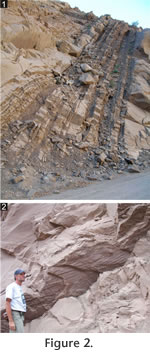|
|
|
STRATIGRAPHiC AND SEDIMENTARY CONTEXTThe Vinchina broken-foreland basin, in north-western Sierras Pampeanas, La Rioja province, Argentina (Figure 1), was filled by non-marine deposits mostly assigned to the Vinchina and Toro Negro Formations (Turner 1964; Ramos 1970). The stratigraphic scheme of the basin was recently modified by Ciccioli (2008) and Ciccioli et al. (2010). The basin infill is divided into five formational units (Figure 1). From bottom to top, they are: Puesto La Flecha (Paleocene-Early Eocene), Vallecito (Eocene), Vinchina (Oligocene-Early Miocene), Toro Negro (Miocene-Early Pliocene) and El Corral Formations (Pliocene).
The Vinchina Formation is a thick red-bed succession of 5100 m thick, essentially composed of reddish sandstone, mudstone and intra-and extraformational conglomerate with abundant desiccation cracks (Turner 1964;
Tripaldi et al. 2001). This sedimentary succession is interpreted as having been deposited by different fluvial styles (anastomosed, meandering and braided channels) with minor intercalations of shallow lacustrine and eolian
deposits of semiarid climate conditions (Turner 1964;
Tripaldi et al. 2001). The unit is divided in two members (Ramos 1970). The Lower Member (2156 m thick) consists of thick beds of medium to coarse sandstone with interbedded intra- and extraformational conglomerate and mudstone.
The age of the Vinchina Formation is actually considered Oligocene to Early Miocene since new stratigraphic relationships and K40/Ar40 radiometric dating were reported for the Vinchina Basin (Ciccioli et al. 2005; Tedesco 2007; Ciccioli 2008; Ciccioli et al. 2010). Previously, Tabbutt et al. (1987) suggested an Upper Miocene age for the Vinchina Formation based on a zircon fission-track age of 7.3 ± 1.2 Ma of uncertain stratigraphic position. Ciccioli (2008) reported for the middle part of the Vinchina Formation in the northern part of the studied area (Los Pozuelos creek) a 25.3 ± 0.9Ma K40/Ar40 dating. These data are consistent with the 8.6 ± 0.3 Ma and 6.8 ± 0.2 Ma K40/Ar40 dating of two vitric tuffs of the middle-Upper part of the overlying Toro Negro Formation (Ciccioli et al. 2005).Trace fossil studied herein are preserved near the base of the Upper Member of the Vinchina Formation, below the 25.3± 0.9 Ma K/Ar dating, consequently considered Late Oligocene in age. |
|
